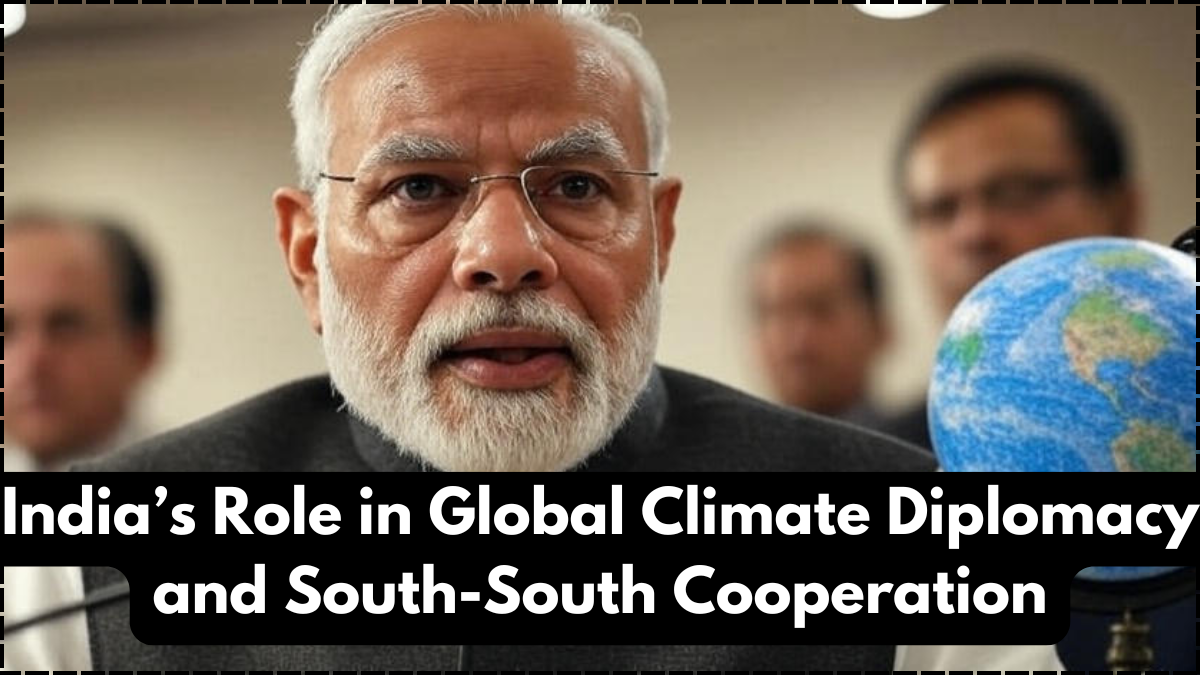The fight against climate change is no longer just about environmental action—it has become a defining factor in international relations and development strategies. At the center of this shift is India climate diplomacy, which has positioned the country as both a responsible global player and a leader in sustainability. India’s approach combines domestic initiatives with international commitments, showing that developing nations can balance growth with green priorities.
By championing renewable energy, pushing for climate justice, and building global partnerships, India has carved a unique space in climate negotiations. Its emphasis on South-South cooperation reflects a vision where developing nations support one another in tackling shared climate challenges. This approach not only strengthens India’s global standing but also ensures that climate diplomacy remains inclusive and equitable.

The Core of India Climate Diplomacy
India has taken significant steps to make climate diplomacy a core part of its foreign policy. Some of the central features include:
- Advocating for climate justice and equity, emphasizing that developed nations must take greater responsibility.
- Leading global initiatives like the International Solar Alliance (ISA).
- Expanding renewable energy capacity with a target of 500 GW by 2030.
- Promoting green hydrogen, electric mobility, and energy efficiency programs.
- Supporting global partnerships for technology transfer and financing for climate adaptation.
Through these strategies, India climate diplomacy reflects the dual goals of advancing development while safeguarding the planet.
India and South-South Cooperation
South-South cooperation is central to India’s role in international climate action. Unlike the traditional North-South dynamic, South-South cooperation focuses on collaboration among developing nations to share knowledge, resources, and technologies. India has embraced this model as part of its climate leadership.
Key contributions include:
- Extending concessional credit lines and grants to developing countries for renewable projects.
- Training climate professionals and policy experts from partner nations.
- Sharing low-cost technologies such as solar pumps and efficient cookstoves.
- Establishing networks for knowledge exchange across Asia, Africa, and Latin America.
By aligning India climate diplomacy with South-South cooperation, the country shows that global partnerships can be inclusive and based on solidarity rather than dependency.
India’s Climate Diplomacy Contributions
| Initiative/Action | Focus Area | Impact on Global Partnerships |
|---|---|---|
| International Solar Alliance (ISA) | Renewable energy cooperation | Strengthens solar adoption worldwide |
| Coalition for Disaster Resilient Infrastructure (CDRI) | Climate resilience planning | Helps vulnerable nations prepare for disasters |
| Paris Agreement Commitments | Emission reduction, clean energy | Boosts India’s credibility in climate talks |
| South-South Cooperation Programs | Technology sharing, financial aid | Enhances solidarity among developing nations |
This table shows how India climate diplomacy is not limited to speeches or promises but backed by actionable initiatives that foster global partnerships.
Opportunities and Challenges
India’s position as a climate leader creates multiple opportunities. It can expand renewable technology exports, deepen ties with Africa and Asia, and secure green financing through multilateral platforms. Moreover, a strong climate stance enhances India’s influence in global forums such as the G20 and COP summits.
However, challenges remain. Domestic coal dependency, balancing industrial growth with emissions reduction, and securing adequate funding for clean projects require continuous effort. India must also ensure that its climate commitments align with the development needs of its vast population. These hurdles highlight why global partnerships are critical to India’s climate vision.
Conclusion
The role of India climate diplomacy is far more than symbolic; it is actively shaping the future of international cooperation on climate issues. By integrating South-South cooperation with strong multilateral engagement, India has shown that developing nations can lead by example. Its focus on equity, technology sharing, and renewable energy ensures that global partnerships become a foundation for sustainable development worldwide. With consistent action and innovative leadership, India’s climate diplomacy can remain a powerful force for a greener, fairer future.
FAQs
What is India’s approach to climate diplomacy?
India emphasizes climate justice, renewable energy leadership, and building global partnerships through both South-South and multilateral cooperation.
How does South-South cooperation strengthen India climate diplomacy?
It allows India to share technology, provide financial support, and collaborate with developing nations on climate challenges.
What are some key global initiatives led by India?
Major initiatives include the International Solar Alliance, Coalition for Disaster Resilient Infrastructure, and commitments under the Paris Agreement.
What challenges does India face in climate diplomacy?
Challenges include dependence on coal, funding gaps for renewable projects, and balancing development with emissions reduction.
Click here to learn more